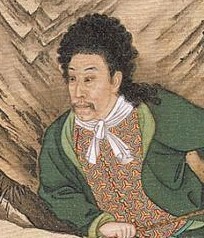Emperor Gwidh-mjen
| Emperor Gwidh-mjen | |||||
|---|---|---|---|---|---|
 Gwidh-mjen in Casaterran costume | |||||
| Emperor of Themiclesia | |||||
| Reign | May 3, 1679 – Jun. 2, 1738 | ||||
| Coronation | May 20, 1679 | ||||
| Predecessor | Emperor 'rjem' | ||||
| Successor | Emperor Hrus-mjen | ||||
| Regent | Empress Dowager 'jik | ||||
| Born | 司馬馨 slje-mra′-sk′jeng 2 February 1660 Middle Palace | ||||
| Died | 2 June 1738 (aged 78) nTrjang-rakw Palace, Rak-lang | ||||
| Burial | Rear Mausoleum (後陵) | ||||
| Spouse | Empress Mja | ||||
| Issue |
| ||||
| |||||
Emperor Gwidh-mjen (Shinasthana: 惠文帝, gwidh-mjen-tegh; Feb. 2, 1660 – Jun. 4, 1738) ruled Themiclesia from 1679 to his death in 1738. During his 59-year reign, Themiclesia lost control of Camia and reformed its military to protect existing and recapture lost territories. Gwidh-mjen personally focused on diplomacy and established at least four permanent missions from Casaterran states and Fyrland.
Early life
Gwidh-mjen was the first child between Emperor ′rjem′ and Empress ′jik on Feb. 2, 1660.
Reign
Minority
Gwidh-mjen came to the throne during his minority, aged 18. The Empress Dowager functioned as regent, making decisions with her court until Gwidh-mjen was 20. The previous emperor's prime minister, the Lord of Goh, was retained by Gwidh-mjen for the first few years, until he died in 1684; Goh dominated the court and advocated for the heavy-handed suppression of Camian appeals for greater financial autonomy from Themiclesia. In 1663, the Themiclesian court ordered the Marine Prefect to extend the Wood Fine to all 18 Camian counties.[1] That officer was assassinated in 1681, the assassin never discovered. A new tax was levied on four Camian counties out of the idea that disgruntled locals were harbouring the assailant. Camian leaders saw this as a unfair punitive act and sent petitions to the Emperor for the dismissal of the Lord of Goh, but Gwidh-mjen did not respond to their request.
Maverican acquisition
First Camian War
In 1689, prominent Camian opinion leaders motivated the militia of Gjung County to raise up arms against the government. The revolt soon spread to the counties affected by the new tax. The Colonial Army, stationed in Camia, suppressed the revolt with excessive brutality and was the subject of much criticism on both shores.[2] The Lord of Gah refused to resign under domestic pressure, but the Commerce Secretary rapidly dismissed 20 high-ranking officers the Colonial Army to appease the general disquiet in Camia.[3] However, some prominent loyalist Camians believed that if the army's actions were justified, these senior officers, many of whom personally uninovlved, should not be dismissed; if they were not, then the implicated officers should be punished more severely. The resulting indignation and uncertainty is understood as a direct motivation for Camian independence in 1701.
Camian independence
In 1701, Din Maeng (known in contemporary Tyrannian literature as Mr. Dimming) was proclaimed King of Camia by a number of prominent individuals
Personal life
| Styles of Emperor Gwidh-mjen | |
|---|---|
| Reference style | The Emperor |
| Spoken style | Your Majesty |
Family
Commemoration
Mausoleum
The remains of Emperor Gwidh-mjen were enclosed in four sarcophagi and lay in state at the Hên'-lang Palace for 27 months as royal customs dictated. He was interred in 1740 at the Rear Mausoleum (後陵, gos-rjeng).
Shrine
At the point of his death, Gwidh-mjen was considered a sufficiently-successful ruler to merit a permanent shrine to himself. Some courtiers believed that the loss of Camia prohibits such a shrine, but successes in the latter part of his reign were used by others to argue for one. This shrine and its compound were constructed across in Dah County (杜縣), across the River Kaung from Kien-k'ang, c. 1740 and was initially named ngwadh-tsung (外宗). After the shrine to Emperor Hrus-mjen (r. 1744 – 1761) was also constructed on the same bank, the former was renamed dah-tsung (杜宗) for disambiguation. It was originally staffed with an administrator and protected by detachments of the Royal Guards. Daily sacrifices in cattle and sheep were offered by the staff, and they shared the offerings amongst themselves or sold them to the public. In the early 19th century, the personnel at dah-tsung was withdrawn, allowing it to fall into disrepair with a number of other shrines as the government sought to divert royal expenditure towards other ends. While the buildings were ruined, the govenrment periodically expelled those taking shelter in it.
During the Pan-Septentrion War, the ruins of the dah-tsung were used as a garrison by Themiclesian troops on the west bank of the Kaung preparing to cross it. This resulted in some damage to the bronzes and other artifacts that were burried in the shallow earth under the ruins. Temporary structures were demolished by conservationists and academics that studied the area. In 1959, the dah-tsung grounds were declared a public park with roofs built over the ruins that once stood there.
See also
Notes
- ↑ The Wood Quota was a tax levied on all privately-grown trees that were above three feet in diameter, to exempt them from royal logging, since these were useful for shipbuilding and major construction projects. The Camians protested that privately-grown trees naturally grew to this size and automatically became royal property if the Wood Fine was not paid annually.
- ↑ Almost 3,000 were killed.
- ↑ The Commerce Secretary controlled the Navy and Colonial Army as part of his overseas jurisdiction.